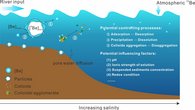The 10Be/9Be ratio in seawater has shown great potential in tracing water mass mixing, shelf water exchange and ocean circulation, and the ratios recorded in authigenic marine sediments have been proposed to be a promising proxy for past continental weathering and denudation. Unlike most isotope systems, the oceanic 10Be/9Be ratio is set by individual fluxes of two isotopes: while 9Be is mostly delivered by river input, the 10Be mainly originates from direct atmospheric deposition. At the land-ocean contact, the fast-changing physical and chemical conditions will heavily affect the distribution of Be isotopes in dissolved and solid phases through various potential processes (Fig), and thus modify their delivery to the ocean. However, by which means and to what extent the Be signal will be altered in this area are still not clear. To gain a better understanding of the processes and fluxes involved, the Be isotopes in dissolved phases, suspended particles and bottom sediments along salinity transects in two large estuaries (the Changjiang estuary and Amazon estuary) will be systematically analysed, together with other hydrochemical proxies such as pH and dissolved oxygen (DO). Samples employed in this project are provided by Cruise KECES (Key Elements Cycling in the Changjiang-Estuary-Shelf Transect) in September 2019 and METEOR Cruise M147 (Amazon – GEOTRACES) in April and May 2018.
Cooperation Partners
- Prof. Dr. Shouye Yang, State Key Laboratory of Marine Geology, Tongji University
- Dr. Ergang Lian, State Key Laboratory of Marine Geology, Tongji University
- Prof. Dr. Martin Frank, GEOMAR Helmholtz-Zentrum für Ozeanforschung Kiel
- Prof. Dr. Florian Scholz, GEOMAR Helmholtz-Zentrum für Ozeanforschung Kiel
- Dr. Ed Hathorne, GEOMAR Helmholtz-Zentrum für Ozeanforschung Kiel
Time Frame
- 2019 - 2023
Funding
- China scholarship Council (CSC)





